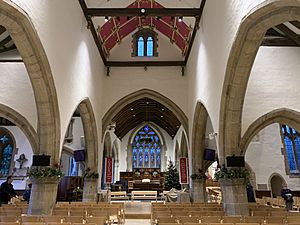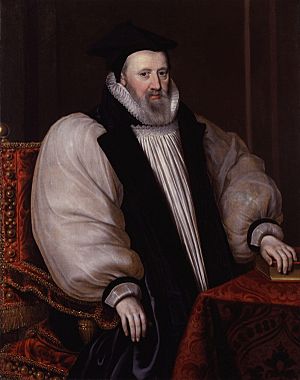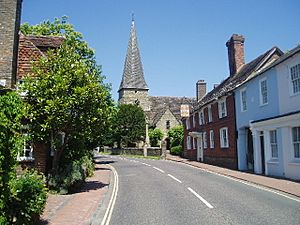All Saints Church, Lindfield facts for kids
Quick facts for kids All Saints Church, Lindfield |
|
|---|---|

Interior of All Saints Church, Lindfield
|
|
| 51°00′58″N 0°04′42″W / 51.01622°N 0.07837°W | |
| Location | High Street, Lindfield, West Sussex |
| Country | England |
| Denomination | Church of England |
| Architecture | |
| Heritage designation | Grade II* listed |
| Style | Early English |
| Years built | Fourteenth century |
| Administration | |
| Parish | Lindfield, West Sussex |
All Saints Church, Lindfield is a historic Church of England church located in Lindfield, West Sussex, England. It was built a long time ago, during the Middle Ages, in a style called Early English.
The church is mostly made from local sandstone and was built in the early 1300s. For a while, in the late 1500s and early 1600s, the church became quite run down. But in the mid-1800s, it was fully repaired. This was largely thanks to a dedicated priest named Reverend Francis Hill Sewell.
Contents
A Look Back: Church History
Ancient Roots in Lindfield
This church has been part of the village of Lindfield, West Sussex for a very long time. Lindfield itself was first mentioned in a Saxon document from 765 AD. This document talked about "open land with lime trees." It also mentioned that King Ealdwulf gave land to build a special church called a minster. This early church might have been on the same spot where All Saints Church stands today.
The Church in the 1100s
Around 1150, an important church leader named Archbishop Theobald confirmed that the land around Lindfield belonged to a group of priests in South Malling. The head priest from South Malling then became the main priest for Lindfield church. This meant he had to live in Lindfield for at least three months each year. He was also in charge of making sure the church was kept in good repair.
Building in the 1300s
The church you see today was mostly built in the early 1300s. It was constructed using local sandstone and had a roof made of special stone slabs. The tall tower, also from the 1300s, has a pointed roof covered in wooden tiles and a metal weather vane.
The church has a main area called a nave and smaller areas called chancels. The tower has three levels. The bottom level has a window shaped like a three-leaf clover. The middle level has a tall, narrow window, and the top level has a round window. The chancel also has chapels on its north and south sides, with thin pillars typical of the Late Perpendicular style.
Challenges in the 1600s
In the late 1500s and early 1600s, the church started to fall apart. It became almost like a ruin. In 1617, Archbishop George Abbot gave permission for the church leaders to rebuild it. He noted that the church was "in ruins."
Keeping the church in good shape was a big problem for the local community. There were only about 290 people who regularly attended church and 10 who did not. One person, Thomas Pelling, was even fined for "refusing to pay his taxation for the repayring of the decayed church of Lindfeild."
Neglect in the 1700s
During the 1700s, the church continued to struggle. It was said that the church and the area around it were very neglected. In 1758, records show that the priest at the time was only paid £20 a year. He asked for more money, saying it wasn't enough, but his request was turned down. Because of this, there was often no priest to lead services, and church meetings stopped happening.
Restoration in the 1800s
By the mid-1800s, the church's income was still very low. However, things began to change in 1841 when Reverend Francis Hill Sewell arrived. He was a university graduate and stayed as the priest in Lindfield until he passed away in 1862.
In 1847, a group called the Cambridge Camden Society looked at the church. This group wanted to bring back the beautiful architecture of churches from the Middle Ages. They described All Saints Church as being in a "most wretched condition." They were surprised that any restoration was even being tried. They noted that the work done so far, mainly on the windows, was good, but the overall layout of the church was still a mess.
Reverend Sewell himself gave more than £650 of his own money towards the repairs. The total cost was estimated to be around £2,000. Thanks to these efforts, the church was fully restored in the mid-1800s.
A Landmark in the 1900s
On September 10, 1951, All Saints Church was officially recognized as a Grade II* listed building. This means it is a very important historic building that needs to be protected.
All Saints Church Today
Today, the church still has many of its old features. For example, several tombs from the 1700s can still be seen. The North chapel has a marble plaque for John Court, who died in 1794. It also features a tall, pointed monument with oval decorations. The south chapel has a plaque for Sarah Board, who passed away in 1765, decorated with a draped urn and a family crest.
In 2013, a project called "Aspire" was started. Its goal was to "repair, re-order and re-vitalise" the church. Much of this work was finished in 2018. This included removing the old pews and replacing the stone floor with a new one that has underfloor heating.
Today, All Saints Church continues to serve the people of Lindfield. It is led by Reverend Steve Nichols.
Gallery
See also
- Grade II* listed buildings in West Sussex
- List of places of worship in Mid Sussex




